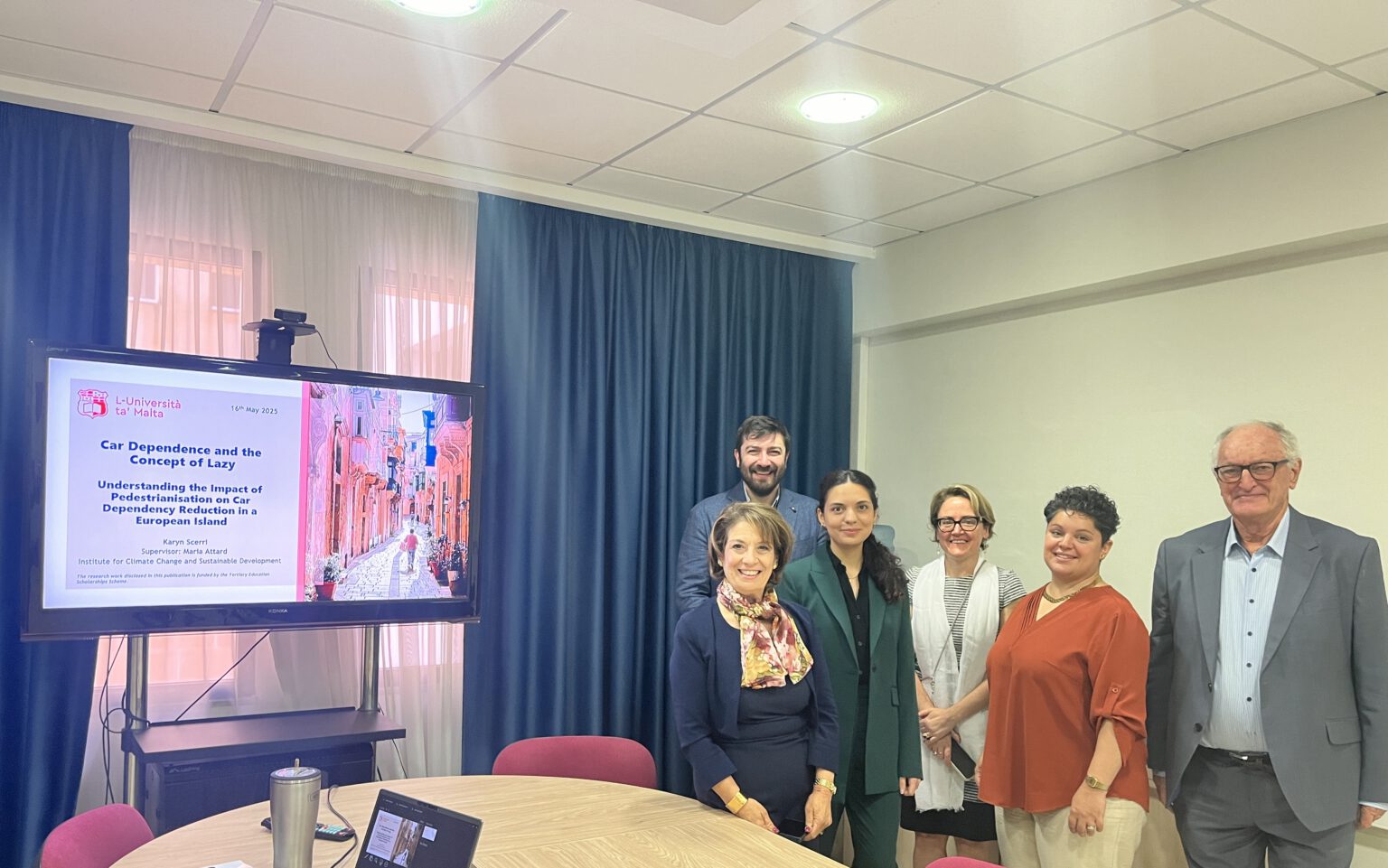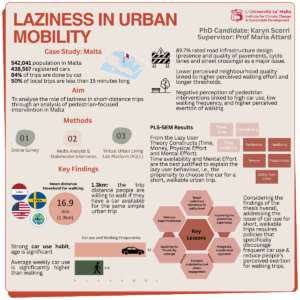Does laziness play a role in shaping people’s mobility behaviour?
How can pedestrian-focused interventions change the way we move through urban areas?
Last month, Karyn, currently working as a researcher on the metaCCAZE project, successfully defended her PhD thesis on sustainable mobility at the University of Malta. Her thesis focused on travel behaviour, specifically people’s propensity to use the car for short, walkable trips in the principal urban area of Malta.
Motivation for the research
With a population of 542,041 persons and over 438,567 registered cars, Malta faces multiple challenges associated with car dependence, with over 84% of trips being done by car. This sedentary, car-dependent behaviour has numerous social, economic and environmental impacts.
The research sought to understand the role laziness may play in short-distance trips by applying the Lazy User Theory and the Perceived Exertion Theory within the context of Malta’s principal urban area, where 60% of the population resides.
The thesis involved a mixed-methods approach, including surveys with over 800 people and a combination of analytic methods, including PLS-SEM, mediation analysis, content analysis and sentiment analysis. The survey collected key data including;
- What aspects affect people’s choice to use the car over walking for short trips in Malta
- Walking and car use frequency
- How far they’re willing to walk if a car is available for that same trip (distance threshold)
- How easy or hard they feel walking is (perceived exertion)
- What they think of their neighbourhood’s walkability
Additionally, to provide more in-depth qualitative data, the research also included interviews with key stakeholders, and a co-creation workshop was held with the community. Following this, a virtual urban living lab was created to gauge people’s reactions towards proposed street interventions within their urban area, understand what they would like to see in their urban environment and highlight the key barriers and enablers of implementing interventions in the urban realm.
Key Findings
- Car habits run deep
Respondents exhibited a strong car use habit and over 93% had access to a car and used it frequently and significantly more than walking.
- The average ‘walkable’ distance was around 1.3km
This equates to around 17 minutes of walking. This is slightly less than the widely cited 1.6km threshold, and less than figures found in places like the Netherlands or Sweden. However, this resonates with the relevance of the x-minute cities, promoting the ability for people to access their daily needs and activities within 15-20 minutes of walking or cycling
- Time and mental effort are critical factors for mode choice for local short trips
Physical effort was not a significant factor for short urban trips, indicating that Malta’s dependence on the car is not being fuelled by how physically effortful walking is, but rather by other determinants that are influencing this lazy user behaviour.
- Interestingly, people who walk more often perceive their neighbourhoods more negatively
Those who experience the streets up close notice their flaws more than people who mostly travel by car. 89.7% of participants rated road infrastructure design (presence and quality of pavements, cycle lanes and street crossings) as a major issue in their neighbourhood.
What This Means for Urban Planning
This research suggests that walkability isn’t just about distance, it’s also about perception, comfort, and habit. Several policy suggestions were highlighted, including
- Make walking easier, safer, and more attractive and embrace co-creation and experimentation in urban intervention
- Target specific trip types (like school runs) for behaviour change
- Challenge the automatic use of cars through better design and policy
Future work
Looking to the future, the hope is that this research can contribute to a broader conversation about sustainable mobility in Malta, one where active mobility becomes not just possible, but preferable. This research provides a solid foundation for expanding it to diverse trip types, combining the use of the virtual platform with real-life street experiments, capturing longitudinal and before-after effects on travel behaviour.
Want to Know More?
If you’re interested in reading more about the research you can access the published papers here or contact the researcher karyn.scerri@um.edu.mt or the supervisor, Prof Maria Attard on maria.attard@um.edu.mt
The research work disclosed in this publication is funded by the Tertiary Education Scholarships Scheme.
















